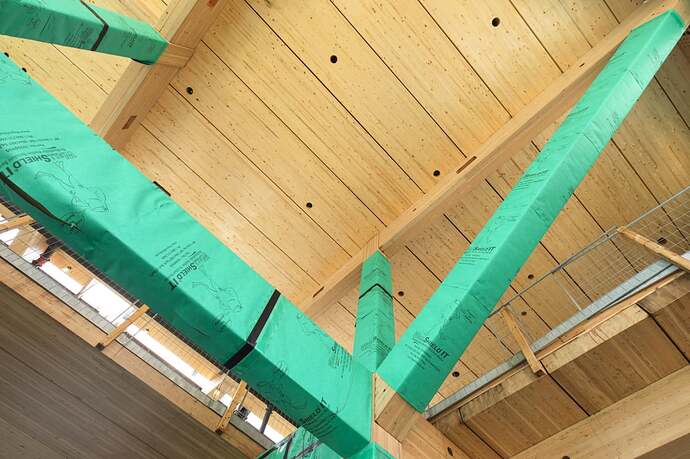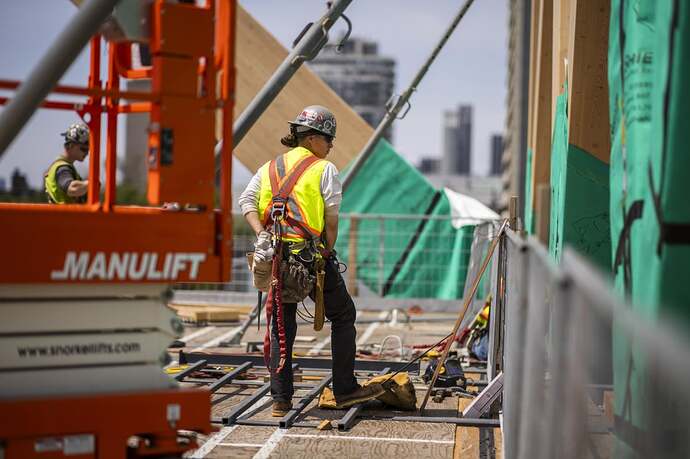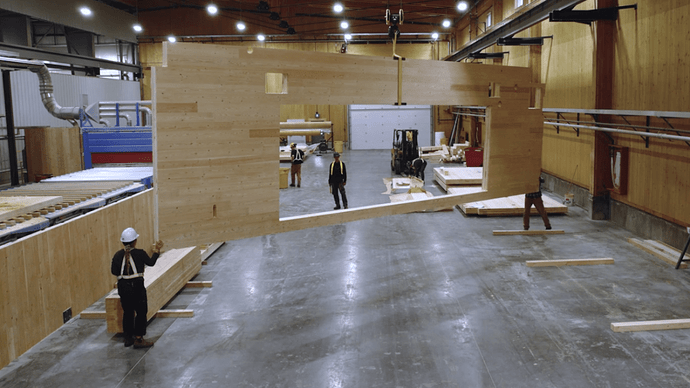Lumber was once a go-to building material before concrete and steel took over. Now, reborn as mass timber, it may be on the cusp of a comeback as the construction sector steps up its green transition.
Mass timber is touted as a landscape-changing, low-carbon material for everything from apartment blocks to office towers. Canada’s market share could triple to $1.2 billion by 2030 – if manufacturers and policymakers can overcome a range of challenges, writes Darius Snieckus.
Wood, one of the world’s oldest building materials, could make a comeback in the next decade if mass timber can overcome a range of challenges as the green transition gains momentum in Canada’s construction industry.
This will not be the lumber of days gone by, chopped and sawed and hammered into homes and buildings in the years before steel, cement and glass radically transformed architecture in the 20th century.
Mass timber – a generic term for materials engineered out of laminated lumber, veneer and wood strands – is attracting a great deal of attention as Canada seeks to build millions of new commercial, residential and institutional buildings without driving up the country’s carbon emissions.
Lighter than concrete or steel but strong enough for use in load-bearing beams and columns, mass timber has environmental and construction virtues that could dramatically change the building landscape, green construction advocates say.
An industrial roadmap from the Transition Accelerator, an Ottawa-based think tank, argues that using mass timber in place of conventional construction materials could cut “embodied carbon” – the emissions produced during manufacturing – by 40 per cent.
Almost 700 mass timber buildings have been built across Canada in the past decade, with another 150 in development today, ranging across the architectural spectrum from condo developments and ice rinks, office towers and a traditional Cree Sabtuan culture house.
A – literally – high-profile example of this new wave of mass timber construction is now rising on a corner of the University of Toronto. The 70-metre- high Academic Wood Tower on St. George campus will be Canada’s tallest academic wood structure when it opens in 2026.
“The low-carbon impact of the project is, of course, central to the argument in favour of [mass timber],” said Scott Mabury, the university’s vice president of operations and real estate partnerships, who spearheaded the AWT project.
“But the other promises of mass timber building – it should go up faster, ultimately be cheaper, be lighter and so on – still need to be proved in Canada to get it to competitive commercial viability internationally – which it isn’t yet,” he added.
Engineered wood beams that form part of the new Academic Wood Tower on the University of Toronto campus. Toronto, Ont., July 2, 2024. (Photo by Nick Iwanyshyn / Canada’s National Observer)
Building site “laboratory”
The tower was originally conceived in concrete and steel when the Goldring Centre was built in the early 2010s. By 2014 the idea of a mass timber tower was being explored.
Designed by Vancouver-based Patkau Architects and Toronto’s MJMA Architecture and Design, with consulting from Blackwell Structural Engineers, the AWT will be home to the Rotman School of Management, the Munk School of Global Affairs & Public Policy and the Faculty of Kinesiology & Physical Education, among others.
The project price tag has not been disclosed. Funding has come from university donors as well as the federal government, through the Green Construction through Wood programme that is aligned with Canada’s Paris Agreement climate commitments.
The project has been “something of a laboratory" so far, said Mabury, pointing to the “experience, lessons, which you can’t put a price on – big positives for us and the wider industry."
Most of the AWT is built out of Douglas fir sourced from British Columbia, along with some Alberta spruce for concealed panels. Edmonton-based manufacturer Western Archrib has said its wood products are certified by the Forest Stewardship Council, a non-profit group that sets standards for responsible harvesting and forest management. (See factbox: How sustainable is mass timber?)
Due to the tower’s modular design, the components are manufactured off-site at Western Archrib’s facilities in Alberta and Manitoba, and transported to the university building site ready for assembly. As a result, there are “fewer people on site, fewer trucks coming and going, less noise, less disruption to neighbouring buildings,” Mabury said.
But the university had a higher ambition in building its mass timber flagship.
"We felt it fell to us as a public institution to try to help bridge the gap commercializing mass timber for all markets,” Mabury said. “For interests broader than the institution. Canadian society at large.”
The project also aims to spotlight barriers to the take-up of mass timber, Mabury said, noting the lack of standardized design, performance and manufacturing requirements that today continue to undermine the supply and price competition for materials in the construction market.
“The supply is limited,” he said. “A supplier will deliver for a project, but their full capacity is taken up. So, it can be many months before your project comes up.”
Although classed as “fire safe” by regulators, Mabury noted, a new mass timber building still needs a bespoke insurance policy – at premiums up to ten times higher than a similar steel and concrete project. This can impact the cost and competitiveness of projects and undermine mass timber’s acceptance in mainstream construction.
“Not just a tree-planting nation”
Mass timber has unique qualities for greening the built environment, sustainable construction advocates say, not least as a “carbon-lock” due to the fact that the wood used will have absorbed large volumes of CO2 over its decades-long lifetime in the forest.
But the long-term environmental impact of mass timber has come under scrutiny as its profile has been raised in green building circles, with critics pointing to issues linked to logging practices, changes in land use and climate change.
Nevertheless, mass timber proponents believe there is a clear economic development angle for the sector in this country.
"Canada is not just a tree-planting nation,” said Derek Eaton, the Transition Accelerator’s director of future economy and co-author of a sector roadmap produced with a number of industry associations. "We can be a world-leader in mass timber and create a great deal of economic development and the jobs that go with that.”
Canada could take a far larger slice of the expanding global mass timber market than its current $380 million in annual exports, according to calculations in the roadmap that point to an “ambitious vision of increasing the market to $1.2 billion by 2030 and doubling that to $2.4 billion by 2035.” (See factbox: Mass timber “value chain”)
That market growth could boost employment levels in rural and indigenous communities near logging sites, sawmills and mass timber factories. An RBC analysis said the 4,000 current jobs in mass timber manufacturing, technology, forestry, design and engineering could triple by the end of the decade.
Mass timber – particularly in modular designs – could also get a leg-up from new provincial and federal regulations that have raised the height limit for wood buildings to 18 storeys from 12.
British Columbia changed its height limit in April and expanded the use of mass timber in schools, libraries and retail. Ontario has also broadened the use of mass timber to “build more homes faster, keep the cost of construction down and boost our northern economy.”
A builder works on the Academic Wood Tower on the University of Toronto campus. Toronto, Ont., July 2, 2024. (Photo by Nick Iwanyshyn / Canada’s National Observer)
Timber travails
Despite Canada’s extensive forest resources and supply chain expertise, mass timber faces several barriers to expanding its modest 1 per cent share of the North American building materials market.
“At a time when we are concerned about lagging productivity in the national workforce as well as the need to build a lot of housing – and in fact all types of buildings – faster, mass timber presents itself as a golden opportunity,” Eaton said.
But seizing the moment would mean shifting the generally accepted view that wood is primarily an export commodity rather than a natural resource that deserves a national industrial strategy to “harness mass timber’s environmental and economic benefits,” he added.
The mass timber sector needs to break out of a "chicken-and-egg scenario,” said Derek Nighbor, CEO of the Forest Products Association Canada (FPAC), an industry advocacy body.
"Developers and designers are excited by the prospects of working in mass timber, but they need to be sure they can get access to the products they need at the right time and price,” Nighbor said. Manufacturers will only invest in producing mass timber products if they see market certainty in the long-term, he added.
The supply-side pressures are magnified by a shortage of mass timber feedstock, which has different requirements for moisture content and processing than regular lumber products, according to the RBC study.
Transportation poses further cost and carbon complications as 11 manufacturers are based in Western Canada (eight in B.C. alone), while most customers are in the populous provinces of Ontario and Quebec. Mass timber producers looking to scale-up their operations also face hefty costs for equipment and technology that is mainly sourced from Europe.
Workers handle a CLT panel at the Kalesnikoff factory in Castlegar, B.C. (handout from Kalesnikoff Lumber Co.)
Lumber mill to mass timber
Canadian mass timber companies are nonetheless investing in new facilities, betting that builders will adopt low-carbon, engineered wood amid pressure to cut construction-related CO2 emissions.
B.C.’s Kalesnikoff and Chibougamau, P.Q.-based Nordic Structures, two leading players in the emerging sector, have in recent years transformed themselves from lumber mills into mass timber manufacturers.
Nordic Structures has delivered mass timber modules for projects across North America, including low-carbon buildings for Ivy League schools and Toronto’s T3 Bayside office tower.
Kalesnikoff, an 85-year-old firm that converted to mass timber in 2019, revealed plans in March to spend $34 million on a third factory in the West Kootenays to meet growing demand for projects such as a power house for the Ah’ta’apq Creek Hydro project in B.C. and the KF Aerospace Centre for Excellence in Kelowna.
“We are developing product lines that can be adapted to most projects. Sales are up and orders are up,” said Kalesnikoff sales director Devin Harding.
“We are not just providing mass timber, we are providing pre-fabricated solutions that allow developers to solve more than just the single problem of carbon,” he said, pointing to benefits for manpower, logistics, faster construction and aesthetics in building with wood modules.
Despite its modest share of the building materials market today, demand for mass timber is accelerating and “starting to really catch the eye of developers and private builders,” Harding said.
“So, the growth rate is only going to continue.”


